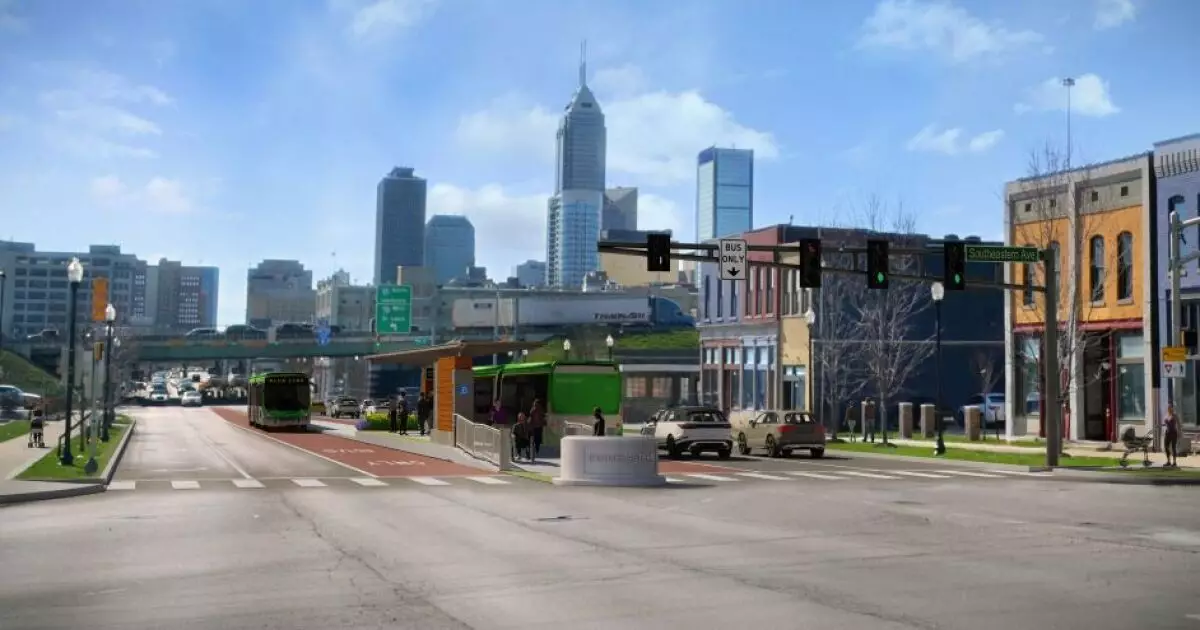In a bold and ambitious move, Indianapolis has opted to finance a significant $125 million bond sale aimed at improving public transit through the establishment of a new rapid bus route. Yet, beneath the surface of this well-intentioned initiative lies an intricate web of financial uncertainties and market conditions that ought to raise concerns among taxpayers and stakeholders alike. The decision to pull the bond sale just a day before its scheduled pricing suggests a volatile financial environment that could jeopardize not only this project, but potentially other future infrastructure endeavors as well.
The Indianapolis Public Transportation Corporation, or IndyGo, seeks to pour these funds into the Blue Line Bus Rapid Transit (BRT) project which promises to connect key locations like the Indianapolis International Airport with downtown, spanning 24 miles. While the project has received an AA-minus rating from S&P Global Ratings, a sense of caution is warranted. Ratings can shift dramatically based on external economic factors. For instance, the bond market was notably influenced by recent tariff-driven turmoil, raising legitimate questions about whether the bond sales will sufficiently cover the expenses associated with the new transit line.
Why Infrastructure Projects Must Consider Market Conditions
The swift rise in municipal bond yields is more than just a passing phase; it stems from deep-rooted anxieties regarding inflation, interest rates, and overall economic health. The decision to delay pricing, articulated by Joe Glass, executive director and general counsel for the bond bank, signifies an acute awareness of these market fluctuations. It is imperative for projects of this magnitude to not only rely on the goodwill and intent behind their execution but also on a favorable macroeconomic climate.
Also concerning is the notion of pledge-based financing that forms the backbone of this project. The bonds will be paid off using a locally dedicated income tax, which in this context, could become a double-edged sword. If the local economy falters, the projected revenues that are expected to support this bond will likely dwindle. With the economic awareness of local governance often falling short, especially during tumultuous times, a facade of economic strength can easily crumble, leaving taxpayers to shoulder the burden of unfulfilled promises.
Promises and Predictions: The Reality of Public Transit Ridership
One of the more troubling aspects of IndyGo’s expansion plans is the vagueness surrounding their projected ridership growth. The farebox recovery ratio, a measurement of how much operational cost is covered through fares, was reported at a mere 5% in fiscal year 2023, down significantly from 9.5% in 2019. The implication that post-pandemic ridership has only recovered to about 75% of pre-COVID levels raises serious doubts about the viability of this venture.
Despite the optimism exuded by S&P analysts who predict steady growth in local income tax revenue, the reality is that ridership figures—while they may slowly improve—are not guaranteed to return to pre-pandemic numbers. If the proposed Blue Line does not generate the expected traffic, it could become a fiscal black hole, draining public funds and yielding little in return. Are we prepared to watch tax dollars flow into a public transit system that lacks the ridership support to justify such an expenditure?
Public Accountability: A Missing Component in Infrastructure Development
Moreover, levels of accountability within the bond issuance process appear to be inadequately defined. It is rather unsettling that the bond bank—which has vowed not to seek appropriations from the City-County Council to restore any potential reserve fund deficiencies—entails inherent risk for taxpayers. Such a lack of commitment to fiscal responsibility could open the floodgates for future mismanagement and inflated debt that the general public isn’t prepared to shoulder.
When projects such as the Blue Line are financed through specialized income taxes without robust safeguards and transparent financial practices, it puts local taxpayers at a disadvantage. This mindset of default risk should be a source of public outcry, yet the discourse surrounding public infrastructure projects often lacks the necessary vigilance.
A Call for Balanced Perspectives
As Indianapolis embarks on this ambitious public transit initiative, a clarion call for caution and due diligence is needed. The path to modernizing transit infrastructure should not blindly follow the allure of future growth, especially when grounded in shaky financial ideals. We must strive for a system that prioritizes both innovation and responsibility, demanding transparency in financial projections and accountability in municipal governance.
In an era where investment in public transit is crucial for sustainability, especially in urban settings, redefining the conversation around fiscal responsibility and public engagement is essential. Initiatives like the Blue Line can potentially transform Indianapolis—but only if built on a foundation of realistic expectations and thorough economic analyses. With taxpayer dollars on the line, it is our responsibility to advocate for the financial integrity of such significant ventures.


Leave a Reply